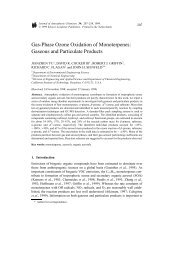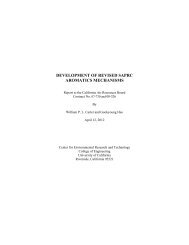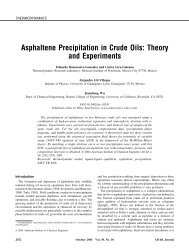Density functional theory for chemical engineering: From capillarity ...
Density functional theory for chemical engineering: From capillarity ...
Density functional theory for chemical engineering: From capillarity ...
You also want an ePaper? Increase the reach of your titles
YUMPU automatically turns print PDFs into web optimized ePapers that Google loves.
number of more sophisticated statistical-mechanical methods<br />
have also been used, driven by diverse special applications<br />
related to fluid-phase equilibria, polymeric materials, colloids,<br />
and interfacial <strong>engineering</strong>. These more rigorous theoretical<br />
methods are based on molecular simulations, 10,11 liquid-state<br />
theories, 12,13 polymer self-consistent field <strong>theory</strong>, 14-16 and classical<br />
density <strong>functional</strong> <strong>theory</strong>. 17,18 For example, powerful<br />
field-theoretical methods have been developed <strong>for</strong> predicting<br />
the mesoscopic structures of polymeric systems; 14 general<br />
equations of state have been established <strong>for</strong> fluid-phase equilibrium<br />
calculations involving virtually any system of practical<br />
interest. 19,20 With the rapid increase of computer power, molecular<br />
simulation and ab initio quantum mechanics promise to<br />
offer a universal approach to the realization of the full potential<br />
of statistical mechanics. 21 However, simulation cannot replace<br />
all analytical methods in the near future, not only because<br />
significant progress has yet to be made <strong>for</strong> modeling multiple<br />
time- and length-scale problems that cannot be described by<br />
current simulation methods but, more important, interpretation<br />
of simulation data, much like experimental results, often requires<br />
analytical tools to attain a good understanding of the<br />
underlying physics. Analytical methods are by and large much<br />
more efficient than direct simulations <strong>for</strong> predicting the molecular<br />
constituents of a system with “tailored” properties, a<br />
reverse problem that is of much interest in practical applications<br />
including drug design, gene mutation, and materials synthesis.<br />
Classical density <strong>functional</strong> <strong>theory</strong> (DFT) provides a compromise<br />
between conventional semiempirical methods and molecular<br />
simulations. 18,22-24 On the one hand, DFT is able to<br />
retain the microscopic details of a macroscopic system at a<br />
computational cost significantly lower than that used in simulation<br />
methods. On the other hand, DFT is more rigorous than<br />
conventional phenomenological theories. It is applicable to<br />
both uni<strong>for</strong>m and confined systems within a self-consistent<br />
theoretical framework. Although the practical value of DFT <strong>for</strong><br />
modeling interfacial properties was recognized soon after the<br />
methodology was first introduced to classical systems in<br />
1976, 25 its broader applications <strong>for</strong> studying equilibrium and<br />
kinetics of phase transitions, self-assembly, properties of polymeric<br />
materials, thin films, and a variety of biological systems<br />
emerged only recently. Meanwhile, much progress has been<br />
made in recent years in the development of more efficient<br />
numerical algorithms and in the <strong>for</strong>mulation of more realistic<br />
free-energy <strong>functional</strong>s to account <strong>for</strong> the thermodynamic nonideality<br />
attributed to various intermolecular <strong>for</strong>ces.<br />
The purpose of this article is to review, along with illustrative<br />
examples, recent progress of classical DFT in modeling the<br />
phase and interfacial properties of fluids and soft materials.<br />
Following a brief introduction to the basic concepts and new<br />
developments toward a unified free-energy <strong>functional</strong> reflecting<br />
various components of intermolecular <strong>for</strong>ces, the main text<br />
is concerned with applications of DFT to (1) surface tension<br />
and interfacial behavior, (2) adsorption of gas and materials<br />
characterization, (3) wetting transitions, (4) solvation, (5)<br />
freezing and melting transitions, (6) phase behavior of liquid<br />
crystals, (7) properties of polymeric materials and composites,<br />
and (8) molecular self-assembly. This article concludes with a<br />
brief discussion of some possible future applications of DFT to<br />
fabrication of novel materials, environmental protection, and<br />
biomolecular <strong>engineering</strong>.<br />
No attempt has been made to cover all aspects of classical<br />
DFT in the recent literature. There<strong>for</strong>e, significant publications<br />
may have been omitted. The contents discussed here are illustrative<br />
rather than exhaustive. Topics of interest to <strong>chemical</strong><br />
engineers that are not discussed because of the page limitation<br />
include transport in ion channels, 26,27 properties of biomacromolecular<br />
molecules in a “crowded” environment, 28 kinetics of<br />
nucleation, 29 and nonequilibrium phase transitions. 30-32 A review<br />
of these topics would show that DFT is useful not only <strong>for</strong><br />
solving equilibrium problems but also <strong>for</strong> modeling kinetics<br />
and transport phenomena at the molecular level.<br />
Classical <strong>Density</strong> Functional Theory (DFT)<br />
Basic concepts<br />
Classical DFT stems from a mathematical theorem stating<br />
that in an open system specified by temperature T, total volume<br />
V, and <strong>chemical</strong> potentials of all constituent molecules i , the<br />
underlying external potential <strong>for</strong> each <strong>chemical</strong> species, denoted<br />
by i (R), is uniquely determined by the equilibrium<br />
density profiles or by the spatial distribution of molecules<br />
i (R). 33 A corollary of this theorem is that <strong>for</strong> a classical<br />
system, the Helmholtz energy can be expressed as a unique<br />
<strong>functional</strong>* of the density profiles of the constituent molecules,<br />
independent of the external potential. This Helmholtz energy<br />
<strong>functional</strong>, designated as F[ i (R)], is often referred to as the<br />
intrinsic Helmholtz energy, meaning that it is an inherent<br />
property of the system and is independent of the external<br />
potential. The mathematical foundation of DFT, in the language<br />
of quantum mechanics, was first established by Hohenberg<br />
and Kohn 33 in a seminal article published in 1964 concerning<br />
the ground-state properties of an electron gas. It was<br />
later generalized to nonzero temperatures by Mermin. 34 Indeed,<br />
from a mathematical perspective, classical DFT closely resembles<br />
electronic DFT (un<strong>for</strong>tunately both have the same acronym)<br />
except that in the <strong>for</strong>mer case, the density <strong>functional</strong><br />
applies to the structure of atoms or coarse-grained elements of<br />
a polymeric molecule, whereas the latter applies to electrons.<br />
Fueled with a pragmatic computational scheme proposed by<br />
Kohn and Sham, 35 electronic DFT has evolved into a powerful<br />
approach in computational chemistry.<br />
Although in a classical sense, the position of an electron or<br />
atom can be specified by a conventional three-dimensional<br />
vector r, a vector of higher dimensionality is necessary to<br />
describe the spatial configuration of a polyatomic molecule<br />
with m atoms (see Figure 1). A molecular density profile i (R)<br />
is thus defined as the ensemble average of instantaneous molecular<br />
densities<br />
(1)<br />
i R <br />
N i<br />
(r 1 , r 2 ,...,r mi )<br />
where the multidimensional vector R (r 1 , r 2 ,..., r m )denotes<br />
the positions of all atomic particles; N i stands <strong>for</strong> the<br />
number of molecules of species i; and represents a multidimensional<br />
Dirac-delta function, which is infinite when m atoms<br />
*A<strong>functional</strong> is a function whose input variable is also a function. For instance,<br />
in a simple atomic fluid the Helmholtz energy <strong>functional</strong> F[(r)] maps a density<br />
function (r) to a real number <strong>for</strong> the Helmholtz energy.<br />
1170 March 2006 Vol. 52, No. 3<br />
AIChE Journal
















